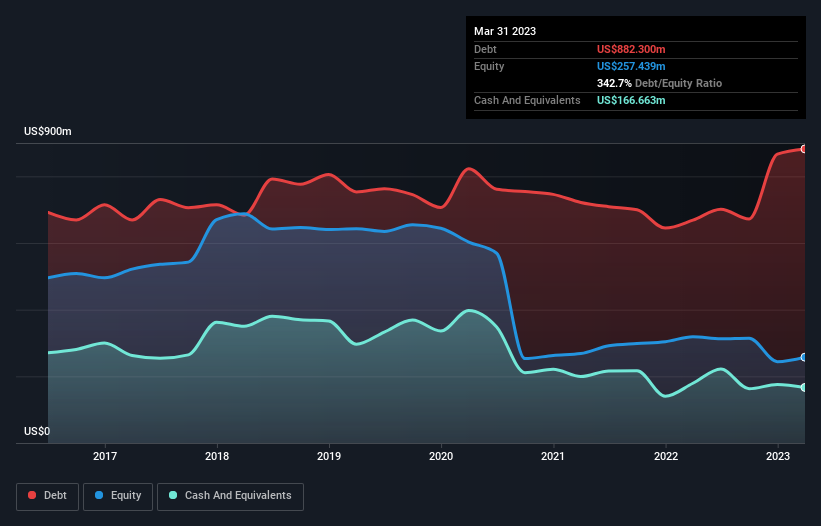
Some say volatility, rather than debt, is the best way to think about risk as an investor, but Warren Buffett famously said that 'Volatility is far from synonymous with risk.' So it might be obvious that you need to consider debt, when you think about how risky any given stock is, because too much debt can sink a company. Importantly, Bluegreen Vacations Holding Corporation (NYSE:BVH) does carry debt. But should shareholders be worried about its use of debt?
Why Does Debt Bring Risk?
Generally speaking, debt only becomes a real problem when a company can't easily pay it off, either by raising capital or with its own cash flow. If things get really bad, the lenders can take control of the business. While that is not too common, we often do see indebted companies permanently diluting shareholders because lenders force them to raise capital at a distressed price. Of course, the upside of debt is that it often represents cheap capital, especially when it replaces dilution in a company with the ability to reinvest at high rates of return. The first thing to do when considering how much debt a business uses is to look at its cash and debt together.
Check out our latest analysis for Bluegreen Vacations Holding
How Much Debt Does Bluegreen Vacations Holding Carry?
You can click the graphic below for the historical numbers, but it shows that as of March 2023 Bluegreen Vacations Holding had US$882.3m of debt, an increase on US$668.5m, over one year. However, it does have US$166.7m in cash offsetting this, leading to net debt of about US$715.6m.

A Look At Bluegreen Vacations Holding's Liabilities
According to the last reported balance sheet, Bluegreen Vacations Holding had liabilities of US$102.7m due within 12 months, and liabilities of US$1.04b due beyond 12 months. Offsetting this, it had US$166.7m in cash and US$586.7m in receivables that were due within 12 months. So it has liabilities totalling US$390.3m more than its cash and near-term receivables, combined.
This is a mountain of leverage relative to its market capitalization of US$495.2m. This suggests shareholders would be heavily diluted if the company needed to shore up its balance sheet in a hurry.
We use two main ratios to inform us about debt levels relative to earnings. The first is net debt divided by earnings before interest, tax, depreciation, and amortization (EBITDA), while the second is how many times its earnings before interest and tax (EBIT) covers its interest expense (or its interest cover, for short). This way, we consider both the absolute quantum of the debt, as well as the interest rates paid on it.
Bluegreen Vacations Holding's net debt is sitting at a very reasonable 2.5 times its EBITDA, while its EBIT covered its interest expense just 5.2 times last year. While these numbers do not alarm us, it's worth noting that the cost of the company's debt is having a real impact. If Bluegreen Vacations Holding can keep growing EBIT at last year's rate of 18% over the last year, then it will find its debt load easier to manage. When analysing debt levels, the balance sheet is the obvious place to start. But ultimately the future profitability of the business will decide if Bluegreen Vacations Holding can strengthen its balance sheet over time. So if you want to see what the professionals think, you might find this free report on analyst profit forecasts to be interesting.
Finally, a company can only pay off debt with cold hard cash, not accounting profits. So we clearly need to look at whether that EBIT is leading to corresponding free cash flow. Over the last three years, Bluegreen Vacations Holding reported free cash flow worth 11% of its EBIT, which is really quite low. That limp level of cash conversion undermines its ability to manage and pay down debt.
Our View
Bluegreen Vacations Holding's conversion of EBIT to free cash flow and level of total liabilities definitely weigh on it, in our esteem. But the good news is it seems to be able to grow its EBIT with ease. Taking the abovementioned factors together we do think Bluegreen Vacations Holding's debt poses some risks to the business. While that debt can boost returns, we think the company has enough leverage now. When analysing debt levels, the balance sheet is the obvious place to start. However, not all investment risk resides within the balance sheet - far from it. For example Bluegreen Vacations Holding has 3 warning signs (and 1 which is concerning) we think you should know about.
At the end of the day, it's often better to focus on companies that are free from net debt. You can access our special list of such companies (all with a track record of profit growth). It's free.
Valuation is complex, but we're here to simplify it.
Discover if Bluegreen Vacations Holding might be undervalued or overvalued with our detailed analysis, featuring fair value estimates, potential risks, dividends, insider trades, and its financial condition.
Access Free AnalysisHave feedback on this article? Concerned about the content? Get in touch with us directly. Alternatively, email editorial-team (at) simplywallst.com.
This article by Simply Wall St is general in nature. We provide commentary based on historical data and analyst forecasts only using an unbiased methodology and our articles are not intended to be financial advice. It does not constitute a recommendation to buy or sell any stock, and does not take account of your objectives, or your financial situation. We aim to bring you long-term focused analysis driven by fundamental data. Note that our analysis may not factor in the latest price-sensitive company announcements or qualitative material. Simply Wall St has no position in any stocks mentioned.
About NYSE:BVH
Bluegreen Vacations Holding
Bluegreen Vacations Holding Corporation operates as a vacation ownership company.
Mediocre balance sheet and overvalued.
Market Insights
Community Narratives



